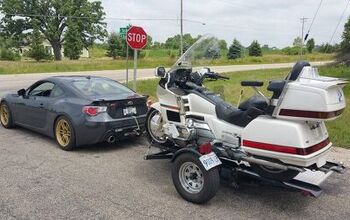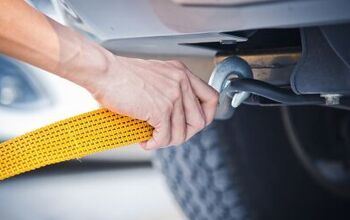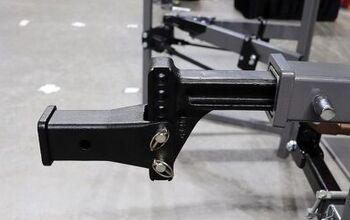How To Tow A Car
Towing a car safely isn’t just about hitching up and hitting the road. It requires the right tools, an understanding of your vehicle’s towing limits, and proper techniques to avoid costly mistakes or safety hazards. With the 2025 Toyota Tundra, drivers have access to a capable platform built to handle towing tasks with confidence.
Here's how to do it right.
Choosing the Right Towing Method
There are several ways to tow a car, each with its own considerations depending on the type of vehicle and equipment available.
Tow Dolly
A tow dolly lifts the front wheels of the vehicle off the ground, allowing the rear wheels to roll. This setup is ideal for front-wheel-drive cars but requires extra precautions for rear-wheel-drive (RWD) or all-wheel-drive (AWD) vehicles. In those cases, the driveshaft must be disconnected to avoid damaging the drivetrain. It’s also important to ensure the vehicle fits on the dolly, stays under the dolly’s weight limit, and that the towing vehicle is equipped with a proper 4-pin wiring harness and sufficient towing capacity.
Tow Bar
Tow bars are commonly used by RV owners to pull a second vehicle. However, most cars don’t come with the necessary frame-mounted connection points. Installing them usually requires removing the front bumper and adding aftermarket hardware, which makes this a less practical option for casual use.
Tow Strap
A tow strap can be used in limited situations, such as pulling a stuck vehicle or moving one across private property. It’s generally not legal or safe for use on public roads. When used, the strap must be attached to a secure frame-mounted point, such as a chain hook on the truck's hitch. The towed vehicle should also be monitored from inside, with a driver handling steering and braking.
Enclosed Trailer (Recommended)
Using a trailer is the safest and most secure method. It eliminates concerns about driveline damage, improves vehicle stability, and allows for more controlled braking and handling. Loading and strapping the vehicle properly is essential, as is understanding the towing capacity of your truck and trailer setup.
Understanding Tundra Towing Specs
The 2025 Toyota Tundra is well-equipped for towing and comes with robust capability figures. Key specs include:
- Max tow rating: 11,175 lbs
- Gross combined weight rating (GCWR): 17,700 lbs
- Gross vehicle weight rating (GVWR): 7,700 lbs
- Curb weight: 6,095 lbs
- Payload capacity: 1,605 lbs
In a sample setup with a 2,000-lb trailer and a 3,389-lb vehicle (e.g., a GR Supra), the total trailer weight reaches 5,389 lbs. Factoring in 200 lbs for the driver and gear, and an estimated tongue weight of 539 lbs, the truck’s gross vehicle weight would be approximately 6,834 lbs — comfortably within the Tundra’s limits. The combined vehicle and trailer weight would come to 11,684 lbs, which also stays well below the 17,700-lb GCWR.
Securing the Vehicle
Properly securing the vehicle to the trailer is essential. The preferred method involves wrapping ratchet straps around the tires and anchoring them through D-rings built into the trailer floor. If this system isn't available, straps can be looped around the lower control arms and secured directly behind the vehicle. Four points of contact should always be used.
Crossing straps is not recommended, as it introduces a single point of failure. If one strap breaks, the entire load can become unstable. Running straps straight back and forward, with opposing tension, ensures redundancy. At the rear, straps can also be wrapped around the axle as long as alignment with the D-rings is maintained. This method avoids compressing the suspension, which can cause loosened straps while driving over uneven terrain.
Setting Trailer Brake Gain
The Tundra includes an integrated trailer brake controller that allows for manual adjustment. A safe starting point is a gain setting of 5. Manual activation of the brake controller can help test braking force. The ideal result is the trailer wheels locking up. If not, increase the gain incrementally until they do, then back it off slightly to avoid over-braking.
Driving and Safety Considerations
Towing changes the dynamics of braking, acceleration, and cornering. Trailer tires are typically rated for speeds up to 65 mph, and stopping distances increase significantly with added weight. Taking wider turns is also important to prevent the trailer from clipping curbs or objects.
The Tundra’s towing-friendly features include an integrated Blind Spot Monitor that accounts for trailer length, power-extending tow mirrors, and an available Wi-Fi trailer camera that projects a live view onto the digital rearview mirror or infotainment screen. Toyota Safety Sense 2.0 comes standard, offering an additional layer of driver assistance during towing.
Conclusion
Towing a car with the 2025 Toyota Tundra is straightforward if done correctly. Understanding your vehicle’s towing specs, using the right method, and properly securing your load can make the difference between a smooth haul and a dangerous one. With its strong capability, built-in safety tech, and intelligent features, the Tundra is well-suited for weekend racers, movers, and anyone needing to pull serious weight.
Become an AutoGuide insider. Get the latest from the automotive world first by subscribing to our newsletter here.
More by AutoGuide.com Staff






















![Why Is This Dodge Viper Towing An F1 Car? [Video]](https://cdn-fastly.autoguide.com/media/2023/06/07/12416434/why-is-this-dodge-viper-towing-an-f1-car-video.jpg?size=350x220)












Comments
Join the conversation
You should remind your readers that payload capacity is truck specific and that manufacturer's advertised numbers are "up to". So the actual payload for any given truck is usually less; sometimes a lot less. You also assume the tongue weight will be the minimum 10% which isn't always the case. It also depends on the type of trailer. In your example of a car hauler, it's easier to control by moving the car forward or backward inside the trailer. But if you had a flatbed that was just long enough for the car to fit, you might have a problem getting the right balanc. Also, things like travel trailers are completely different animals.